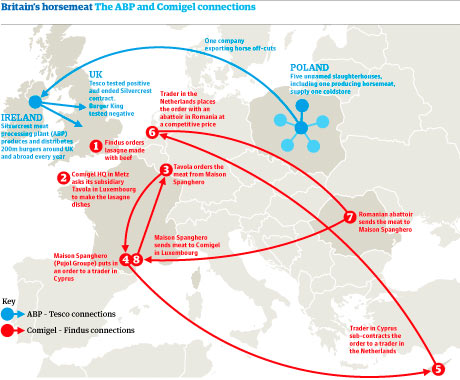Most of the UK press and many of the papers in Switzerland where I live have been pre-occupied in the past weeks with the fact that beef lasagne and other similar ready-made meals from cattle contained traces of horsemeat. This story has now spread worldwide. While in the UK eating horsemeat is an issue of cultural disgust, in Switzerland the main question is one of misinformation and standard setting. Supermarket chains accuse the suppliers of the meals of not describing the ingredients properly. The suppliers accuse the traders who provided the meat that went into the product, who in turn point the finger at the abattoirs where the animals were slaughtered. All-in-all the problems seem to stem from the fact that there is a lack of clear standards throughout the supply chain, there are many steps in the process and the consumer cannot rely on what is written on the label of the final product. The main stories in Switzerland during the past days relate to the way in which horses are reared in some of the countries from which the meat is supplied, and that fact that this does not comply to international standards of animal welfare.
This raises the more general question of traceability, something I have come across a few years ago when we were discussing mining and recycling of metals and minerals. It was impossible to say whether a certain ingot of copper came from a particular mine, and equally difficult to determine the source of recycled concrete in the supply of building materials. The issue was the same as the question with the horsemeat scandal – different suppliers, many steps in the supply chain and unclear labelling of the products along the way.
The other question in this debate is who checks whether what is written on the label is correct? I refer to stories on the Swiss press, where spokespersons say that the goods they received had clear labels, but the content did not fit the bill. Similarly, one can question who checks that every tin of tuna in the supermarket that says “dolphin-friendly” is actually from a sustainable fishing fleet? Often, controls are done on a spot-check basis and that provides room for error, but even if we accept that spot-checks provide a reliable picture, the question is: who checks the controllers? In the case of the horsemeat discussion, the final control in the UK was supposed to be the government, but recent reports suggest this did not happen.
The third aspect that has come to light in the recent discussions about horsemeat and beef lasagne is the fact that there may be criminal interests in deliberately mis-labelling goods, and to substitute a valuable component (beef) with a cheaper alternative (horsemeat). This reminds me of discussions I had in a previous job where timber products were sold as sustainably produced wood, when in fact there were serious questions about the management of the forests in question. The Illegal international trade in animal and plant species often uses the same channels as those used by drugs dealers or human traffickers.
I deduct several key lessons for the conservation community from this debate. First, we need to agree on standards in the supply and production chain. Secondly, labelling needs to be clear and precise. The last company in the supply chain needs to be sure that the origin of ingredients is documented in a manner that serves the purpose of their customers. Thirdly, society needs to ask for better monitoring, be it from government or from universally accepted assessment agencies. Finally, we need to work more closely with national and international law enforcement agencies to stop illegal international trade in animal and plant products.



0 comments
Write a comment